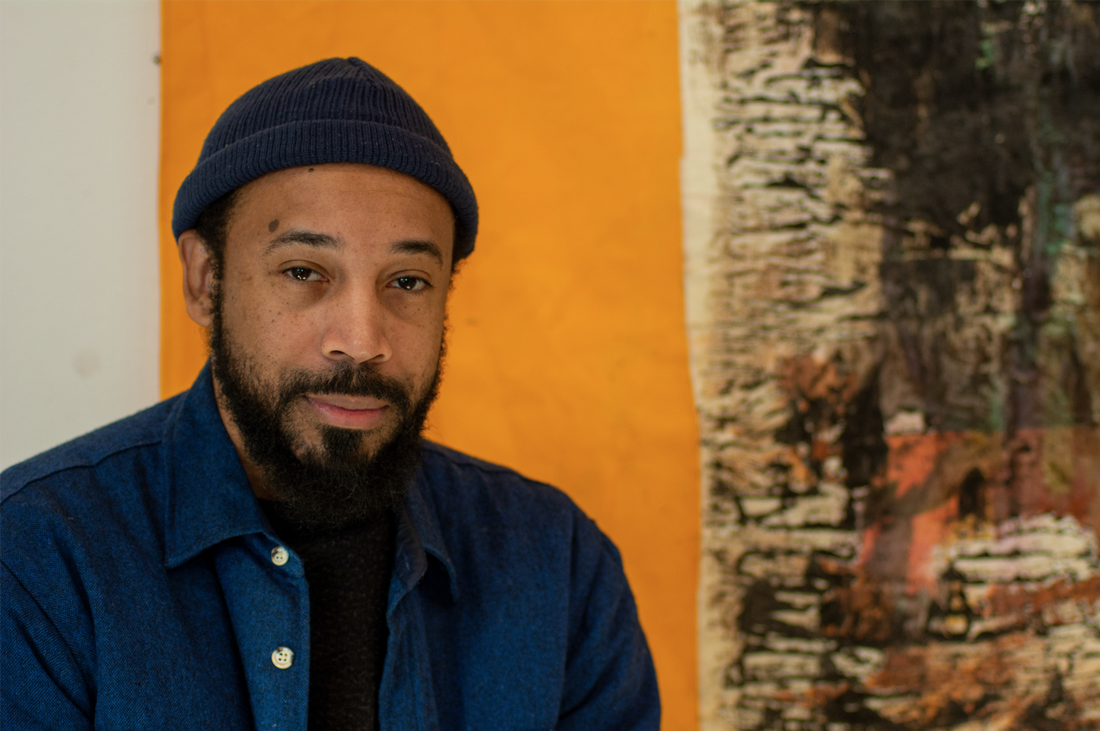|
For the Provincetown Independent
The world’s not necessarily a kind place, says multimedia artist Johannes Barfield, and he hints that there were so many obstacles to overcome between his childhood artistic ambitions and the studio space he currently occupies as a fellow at Provincetown’s Fine Arts Work Center. But not once in an hour and a half did this reserved man whose art is rooted in his own personal history of growing up black in the South disclose specifically what those obstacles were. He remained guarded. Like with his artwork, the things he chooses to disclose or hide are his decisions alone. Born and raised an only child in Winston-Salem, North Carolina, Barfield’s mother headed the city’s Red Cross’s Disaster Services Department and his father was an independent long-distance freight hauler. As a child Barfield would sometimes accompany a parent to a disaster zone or ride shotgun cross-country with his father. His early memories of being on the road with his parents gave him such a strong sense of freedom that he titled one of his earlier pieces from a line from the rapper, Common, “Who Freed Me, Lincoln or Cadillac?” Now, during his seven-month residency in Provincetown, he’s diving deep into childhood memories, expressing complex emotions, preparing for both his upcoming solo show at FAWC’s Hudson D. Walker Gallery that opens Friday, February 21 – 26, and a show in September at Mary S. Byrd Gallery of Art at Augusta University in Georgia. For both shows, his chief topics are family, memory, and cars that are representative of freedom, but also the danger of being black and being pulled over and having a gun put in your face. Barfield uses canvas, paint, asphalt that represents both the road and blackness, joint compound representing institutions, college ruled paper, wheat paste, the adhesive of choice for street artists, images printed on a low-end office printer for a low tech feel, and iron-rich red dirt he brought from North Carolina to make the aggregate that is one of Barfield’s pieces. Another definition of the word, aggregate, by the way, is a construction material used in building roads and also a word that aptly fits Barfield’s work. When he was a child, before he wanted to be an artist, Barfield dreamed of being an archeologist, sifting through layers of past cultures to understand them. That practice now carries over into his adult work. His layered pieces start with a central image—for example, his mother in a car or the cartoon character, Marge Simpson during a fit of road rage, who the child/artist imagined racially ambiguous with her blue Afro. The images are printed on the ruled paper, the paper then attached to the canvas with the wheat paste and smeared with the joint compound. Then it appears as if the asphalt and red dirt have been hurled at the image, obscuring most of its original meaning or context. It is up to the viewer to decide if the artist is forcing or inviting them to be an archeologist, to sift through the layers, through the blackness, to see and experience Barfield’s memories through all that representational material and then…what? It seems the most plausible response is that Barfield is inviting the viewer to experience what it’s like for him to remember through all of that concealment, through all the layers, good and bad, that shroud his memory. Barfield explains that with these materials he’s trying to express a complex emotion. “It’s not sad, it’s not happy, it’s not melancholy; it’s all of those things intertwined. I’m trying to focus beyond binaries, and more on tertiary, a place that is in between, a space that embodies all of those feelings, collapsing those feelings, creating an intersectionality, looking beyond good and bad.” While there are artists who are non-white who wish to be identified simply as artists without their race or ethnicity attached to the label, Barfield is not one of them. “Those individuals are fine for their path,” he says. “They are individuals who may have encountered discrimination, all types of things to hold them in place from being able to progress, or they’re people who don’t want to be pigeonholed in this sub-category. I am very prideful and being black is definitely a part of me, and it’s not something I’d want to deny or put in the background; I don’t want to hide my face. Being a black artist in America means you’re already an obscurity. There are so many people who came before you who don’t look like you. I just want to be true to myself, how I feel and my experiences and being able to share that part of my truth, is the only thing I feel comfortable with and what I’d want to project.” ###
0 Comments
|
Author
John Greiner-Ferris is a politically motivated, multi-disciplinary artist in the Boston area. Sometimes he makes images. Sometimes he writes. Sometimes he does both. Archives
May 2024
Categories
All
|

 RSS Feed
RSS Feed
